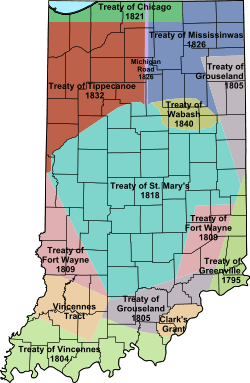Federal Indian Policy facts for kids
The United States government has a special relationship with the Indian Tribes living within its borders. The country's main rulebook, the Constitution, says the federal government is in charge of dealing with these tribes. Experts often divide this relationship into different time periods, each with its own main idea. These periods include:
- Coexistence (1789–1828): Living side-by-side.
- Removal and Reservations (1829–1886): Moving tribes and setting aside special lands for them.
- Assimilation (1887–1932): Trying to make Native Americans live like other Americans.
- Reorganization (1932–1945): Changing policies to support tribes more.
- Termination (1946–1960): Trying to end the special relationship with tribes.
- Self-Determination (1961–1985): Allowing tribes to make more of their own decisions.
Contents
Early Relations and Trade

The year 1790 marked the start of a new period with the passing of the Nonintercourse Act. This law made it clear that no one, not even states, could buy land from Native American tribes unless the United States government approved the sale. This gave the federal government control over trade and diplomatic talks with tribes and their lands. The main goal of this act was to keep peace on the frontier and avoid wars with Native Americans.
During this time, the Bureau of Indian Affairs (BIA) was created in 1824. It was part of the War Department. This meant Native Americans were, to some extent, included in the government's plans. However, arguments over land and laws often went to the United States Supreme Court. The Court decided that the first people to "discover" land had the right to take it from Native Americans, either by buying it or by winning it in a fight. This meant Native Americans were seen only as people living on the land, not as its true owners.
Agreements and Treaties
The federal government managed its relationship with Native American tribes by making formal agreements called treaties. The President and the Senate worked together to create these. By 1840, over 200 treaties had been made.
These treaties were meant to help both sides. The government wanted to make sure that Native American lands didn't fall into private hands. It also wanted to handle all talks with the tribes itself. For the tribes, these talks helped strengthen their unity and leadership. Selling land through treaties also gave tribes a steady income. It also promised them help from the federal government with money, healthcare, and education.
Many of these treaties are still important today. They help decide which tribes are officially recognized by the government. They also protect hunting and fishing rights, sacred places, water and mineral rights, and land claims. Courts often deal with legal cases about these issues. The Supreme Court has mentioned Indian treaties in over 300 decisions since 1799.
Moving West and Relocation
In the early 1800s, many settlers in the eastern United States wanted to move west. This put Native American tribes in a difficult position. Tribes in the east were forced to leave their homes and move to new areas. These new lands often had poor soil and were hard to live on, even though the tribes had been successful where they lived before.
One reason given for moving Native Americans was that it would "give them a space to live undisturbed by white people." The idea was that they could slowly get used to "civilized ways." However, as more settlers moved west, areas like the Nebraska and Kansas territories became crowded. The lands where Native Americans lived were often taken by the government and given to settlers. Even when treaties were signed, Native Americans were often forced to accept smaller reservations or individual land plots. These plots were then often sold to white settlers. This forced movement caused great harm to Native Americans. It made them lose their tribal identity and their independence.
Allotment and Assimilation (1887–1943)
In 1887, the United States Congress passed the General Allotment Act. This was one of the first big attempts to make Native American tribes live more like other Americans. The law aimed to give Native Americans a sense of owning land. It also tried to encourage them to farm, like many Americans and Europeans.
Under this act, tribal lands were no longer controlled by tribal governments. Instead, the land was divided up and given to individual Native American owners. This time became known as the "allotment and assimilation era." The main goal was to make Native Americans fit into mainstream American society. Living life according to traditional tribal ways on reservations was discouraged. Assimilation became the main focus of federal Indian policy.
The BIA was used during this time to control many parts of Native American life. This was all part of the goal to "civilize" Native Americans.
The Allotment era led to a huge loss of tribal lands. In 1871, tribes had about 138 million acres (558,000 km²). By 1934, this had shrunk to only 48 million acres (190,000 km²). This happened mostly because tribal lands were leased, and then sold, to white settlers. Allotment didn't work well because Native Americans were not used to owning land in the same way. They saw the land as their home, not something to be bought and sold.
Ending Special Status and Relocation (1945–1960)
After World War II, some Native Americans, along with government leaders, wanted to fully include Native Americans into mainstream American life. They created a policy to end the government's special role as protector of Indian lands. They also encouraged Native Americans to move from reservations to cities. The idea was that once Native Americans left the reservation, they would find more chances for education and jobs.
As part of this policy, the Bureau of Indian Affairs (BIA) set up offices in cities like Chicago. These offices tried to get Native Americans living on reservations to move to these cities. They also helped them find jobs.
Tribal Self-Determination Era
In the early 1960s, President John F. Kennedy wanted Native American tribes to be recognized as independent nations that could govern themselves. He promised that treaties made before 1960 would be honored by the federal government. He also said that the rights of Native American people would be protected.
This idea became a reality with the Alaska Native Claims Settlement Act (ANCSA) in 1971. This act gave Alaskan Natives 40 million acres (160,000 km²) of land. They also received federal payments of $462.5 million over eleven years. Another $500 million was given to help with mineral development in Alaska. In return, Alaskan Natives gave up their claims to other lands. The act also gave the Alaskan tribes more freedom from the Bureau of Indian Affairs.
Many laws were passed in the 1960s to help Native American tribes. These laws gave them more rights within both their tribal governments and the federal government. In 1968, the Indian Civil Rights Act of 1968 was passed. This law recognized Indian tribes as sovereign nations, meaning they had their own power to govern, while still being part of the federal system.
In the 1970s, two very important laws were passed. The Indian Self-Determination and Education Assistance Act of 1975 allowed tribes to have more control over federal programs that helped Native Americans. Another important law was the Indian Child Welfare Act, passed in 1978. This law gave tribal governments the power to decide child custody and adoption cases on their reservations.


